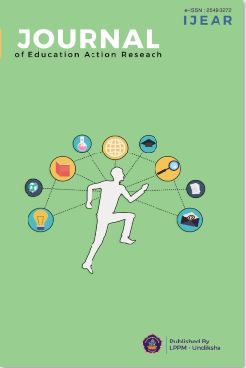Penerapan Model Pembelajaran Kooperatif Tipe Student Team Achievement Division (STAD) untuk Meningkatkan Hasil Belajar Teknik Dasar Servis dalam Permainan Bola Voli
DOI:
https://doi.org/10.23887/jear.v2i4.16344Abstract
This study aims to improve service learning outcomes in volleyball games for students of Class XI K1 of SMK Negeri 3 Sukawati 2016/2017. The subjects of this study were students of Class XI Karawitan 1 in the 2016/2017 school year which amounted to 25 students. This research is a classroom action research conducted in two cycles. Each cycle consists of 2 meetings which consist of planning, action, observation, evaluation, and reflection. Data on student learning outcomes were collected through individual practice tests. The data collected was analyzed using descriptive analysis. The results of this study indicate the application of the cooperative learning model Student Team Achievement Division (STAD) can improve student learning outcomes indicated by the results of the study before the average action is obtained by students with number 7, in the first cycle increases with an average mastery of material by 67 in the less category, with a 17% increase. in cycle II it increased to 74, so the increase occurred at 17%. With enough categories. But overall, there has been a significant increase. Therefore, it is recommended that teachers in the learning process activities can use the STAD type cooperative approach to improve student learning achievementReferences
Angga, Ade. 1984. Teknik Dasar dan Kombinasi Permainan Bola Voli. Bandung FPOK IKIP.
Ajay, K., (2016), Effect of Student Teams Achievemnt Division (STAD) method on problem solving ability in relation to Critical Thinking, International Journal Of Advanced Research and Development, Vol. 1, Page No. 26-30, ISSN: 2455-4030
Arikunto, Suharsimi. dkk. 2008. Penelitian Tindakan Kelas. Jakarta: Bumi. Aksara.
Departemen Pendidikan Nasional. 2001. Pendidikan Jasmani Sekolah Lanjutan Tingkat pertama. Jakarta.
Depdiknas. 2003. Undang-undang RI No. 20 tahun 2003 tentang Sistem Pendidikan Nasional.
Gusniar, (2013), Penerapan Model Pembelajaran Kooperatif Tipe Student Teams Achievment Division (STAD) Dalam Meningkatkan Hasil Belajar Siswa Pada Mata Pelajaran IPS Kelas IV SDN No. 2 Ogoamas II, Jurnal Kreatif Tadulako Online, Vol 2, No. 1, ISSN: 2354-614X
Hidayati, Imtihani Nur Arum, dkk. 2013. Penerapan Model Pembelajaran Kooperatif Tipe Student Team Achievement Division (Stad) Untuk Meningkatkan Aktivitas Dan Prestasi Belajar Kimia Pada Materi Pokok Kesetimbangan Kimia Siswa Kelas XI Man Klaten Tahun Pelajaran 2011/2012. Jurnal Pendidikan Kimia, Vol.2, No.2.
Jus Pariatna, I Wayan & Ida Bagus Nyoman Sudria, Ngadiran Karto Wasono. 2015. “Pengembangan Perangkat Pembelajaran Inkuiri Terbimbing pada Topik Laju Reaksi”. Jurnal Wahana Matematika Dan Sains, Volume 9, Nomor 1, April 2015 38.
Kanca, Nyoman. 2007. Penelitian Tundakan Kelas. Singaraja: Depatemen Pendidikan Nasional Universitas Pendidikan Ganesha.
Nurhadi dan Senduk, Agus Gerrad. 2003 Pembelajaran Kontektual dan Penerapan Dalam KBK. Malang: IKIP Malang.
Rattanatumma, T., (2016), Assessing the Effectiveness of STAD Model and Problem Based Learning in Mathematics Learning Achievement and Problem Solving Ability, Journal of Education and Practice, Vol. 7, No. 12
Sardiman. 2006. Interaksi dan Motivasi Belajar-Mengajar. Jakarta: PT. Raja Grafindo Persada.
Siswanto, R., (2014), Peningkatan Kemampuan Penalaran Dan Koneksi Matematis Melalui Penerapan Model Pembelajaran Kooperatif Tipe STAD Berbantuan Geogebra (Studi Eksperimen Di SMAN 1 Cikulur Kabupaten Lebak Provinsi Banten), Jurnal Pendidikan dan Keguruan, vol 1, No.1
Syarifuddin, Aip. 1997. Pendidikan Jasmani dan Kesehatan 2. Jakarta Depdikbud











